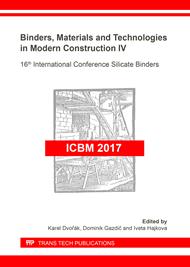[1]
X. Cui, B. Han, Q. Zheng, X. Yu, S. Dong, L. Zhang, J. Ou, Mechanical properties and reinforcing mechanisms of cementitious composites with different types of multiwalled carbon nanotubes, Comp.: Part A 103 (2017) 131–147.
DOI: 10.1016/j.compositesa.2017.10.001
Google Scholar
[2]
P. Rovnanik, H. Simonova, L. Topolar, P. Bayer, P. Schmid, Z. Kersner, Carbon nanotube reinforced alkali-activated slag mortars, Const. and Build. Mat. 119 (2016) 223–229.
DOI: 10.1016/j.conbuildmat.2016.05.051
Google Scholar
[3]
S. Xu, J. Liu, Q. Li, Mechanical properties and microstructure of multi-walled carbon nanotube-reinforced cement paste, Const. and Build. Mat. 76 (2015) 16–23.
DOI: 10.1016/j.conbuildmat.2014.11.049
Google Scholar
[4]
S. J. Chen, B. Zou, F. Collins, X. L. Zhao, M. Majumber, W. H. Duan, Predicting the influence of ultrasonication energy on the reinforcing efficiency of carbon nanotubes, Carbon 77 (2014) 1-10.
DOI: 10.1016/j.carbon.2014.04.023
Google Scholar
[5]
Y.-R. Zhang, X.-M. Kong, Z.-B. Lu, Z.-C. Lua, S.-S. Hou, Effects of the charge characteristics of polycarboxylate superplasticizers on the adsorption and the retardation in cement pastes, Cem. and Concr. Res. 67 (2015) 184–196.
DOI: 10.1016/j.cemconres.2014.10.004
Google Scholar
[6]
F. Kong, L. Pan, C. Wang, D. Zhang, N. Xu. Effects of polycarboxylate superplasticizers with different molecular structure on the hydration behavior of cement paste, Const. and Build. Mat. 105 (2016) 545–553.
DOI: 10.1016/j.conbuildmat.2015.12.178
Google Scholar
[7]
C. Nalet, A. Nonat, Effects of functionality and stereochemistry of small organic molecules on the hydration of tricalcium silicate, Cem. and Concr. Res. 87 (2016) 97–104.
DOI: 10.1016/j.cemconres.2016.06.002
Google Scholar
[8]
M. Liebscher1, A. Lange, C. Schrofl, R. Fuge, V. Mechtcherine, J. Plank, A. Leonhardt, Impact of the molecular architecture of polycarboxylate superplasticizers on the dispersion of multi-walled carbon nanotubes in aqueous phase, J. Mat. Sci. (2017).
DOI: 10.1007/s10853-016-0522-3
Google Scholar
[9]
B. Zou, S. J. Chen, A. H. Korayem, F. Collins, C. M. Wang, W. H. Duan, Effect of ultrasonication energy on engineering properties of carbon nanotube reinforced cement pastes, Carbon 85 (2015) 212-220.
DOI: 10.1016/j.carbon.2014.12.094
Google Scholar


